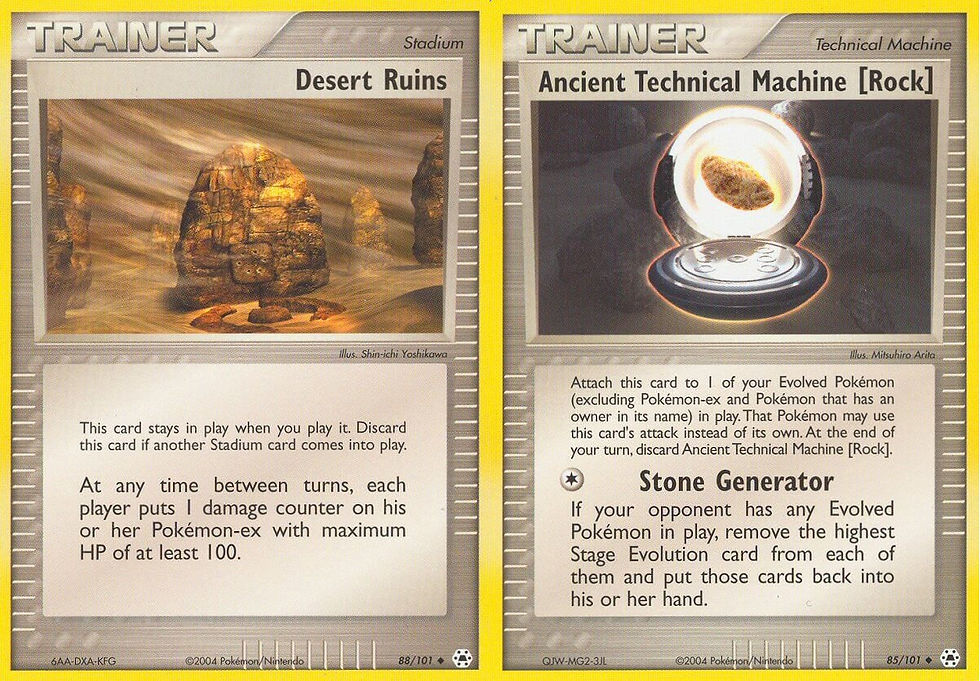
On June 14th, 2004, the Hidden Legends expansion was released in the English language. This was the final set released before the 2004 Pokemon Trading Card Game United States National Championship and World Championship. It was also the final set released before the three Stadium Challenges (comparable in prestige to Regional Championships these days) held across the U.S. in July 2004. As some additional background, 2004 was the year that Nintendo/The Pokemon Company International was beginning to hit their stride after assuming the PTCG from Wizards of the Coast in 2003.

June - August 2004 were some of the most exciting months to be a player. I spent hours and hours playtesting with friends locally in St. Louis and globally through Apprentice. Hidden Legends was a mammoth of a set, but not because of its size (the set had only 102 cards). Many of these cards were immediately relevant to the metagame, while others became more relevant with time...or relevant in new ways. There were many camps erected around the cards from Hidden Legends during the summer of 2004. Traditional summer camps were never of interest to me, but these "Hidden Legend camps" had me singing PTCG-themed campfire tunes and singing them loudly...I was part of the Exploud camp, after all!

Like the recent Evolving Skies format, Hidden Legends gave birth to many new competitive archetypes. Every non-ex Stage 2 in Hidden Legends was immediately viable: Crobat, Exploud, Machamp, Metagross, Shiftry, Walrein and Bellossom. Metagross ex was relevant right out of the gate, while Vileplume ex would have a slower start and lower peak. Hidden Legends also saw the release of several competitive Stage 1's: Milotic, Gorebyss, Lanturn and Rhydon. While Hidden Legends and Evolving Skies both led to diverse formats, the diversity played out in different ways. The Evolving Skies archetypes were (and still are) similar to one another - almost all of them involve big VMAX attackers that largely do the same thing. These archetypes, moreover, have very little time to carry out their copycat strategies due to the quickened pace of games. This further traps the metagame into a strategic monoculture.


The Hidden Legends archetypes, however, differed in attackers and in strategy. Some archetypes aimed to punish Pokemon-ex (e.g. Machamp), some aimed to abuse Double Rainbow Energy (e.g. Crobat/Gorebyss), some aimed to disrupt (e.g. Shiftry), some aimed to heal on a large scale (e.g. Walrein/Milotic), some aimed to heal on a small scale (e.g. anything with a Bellossom tech), some aimed to spread (e.g. Exploud) and some aimed to do several of these things. Hidden Legends also brought Desert Ruins, ATM Rock and Steven's Advice to the PTCG. Every deck either played Desert Ruins or a stadium to counter Desert Ruins. ATM Rock was a game-changing, one-of-tech in most lists and would later be central to one of the most famous decks of all time: Rock Lock. Steven's Advice, perhaps the best draw Supporter ever, raised all ships and led to more consistent, meaningful games across the board.
Before Hidden Legends, TPCi had seen the release of four sets: Ruby & Sapphire, Sandstorm, Dragon and Team Magma vs Team Aqua. If you look at the 14 different 2004 decks memorialized on PTCG Archive, you will find that Hidden Legends has a much larger presence than these other sets. Half of the decks feature attackers from Hidden Legends. The other half incorporate Hidden Legends cards in other ways such as Bellossom support, Desert Ruins/counter stadiums and ATM Rock.

I was 15 years old when Hidden Legends was released and I was still very shaken from what had been happening to Pokemon between 2001 - 2003. I had just witnessed the initial Pokemon craze fade away...Pokemon was no longer cool. My Toys"R"Us PTCG League had recently been cancelled and I had a great deal of uncertainty about the transition from Wizards of the Coast to TPCi. Hidden Legends - this wildly fun set - and its associated tournaments gave me hope that the PTCG might find new life. This was a special kind of hope that the entire community needed in 2004 - especially me.
If multi-dimensional diversity and fortuitous timing aren't quite enough to cement Hidden Legends' place in the hall of fame, then simply recognizing the significance of this set to the story is good enough.
Colin
Additional resources on Hidden Legends:
While a bit more focused on subsequent formats and sets (2005 - 2007), Jason Klaczynski's Looking Back at the EX Era: The Golden Age of the Pokemon TCG provides additional context and expert perspective.
Comments